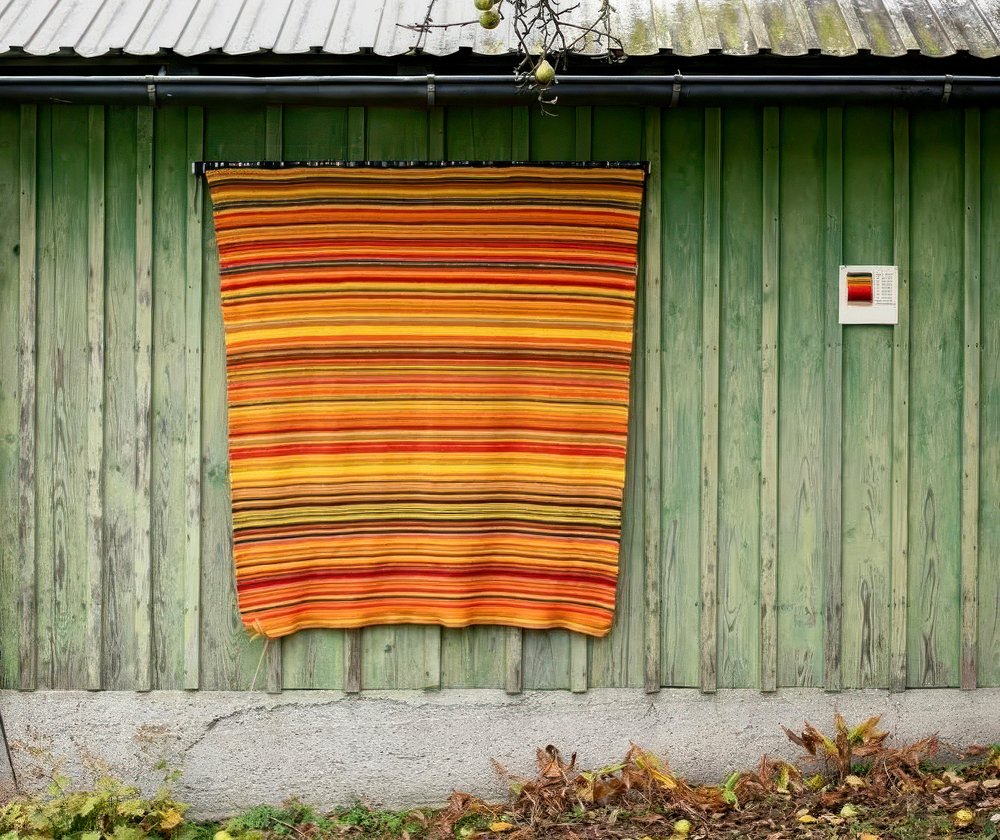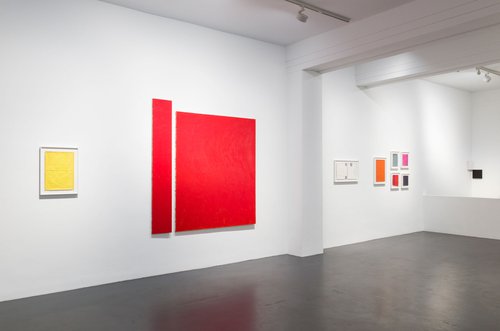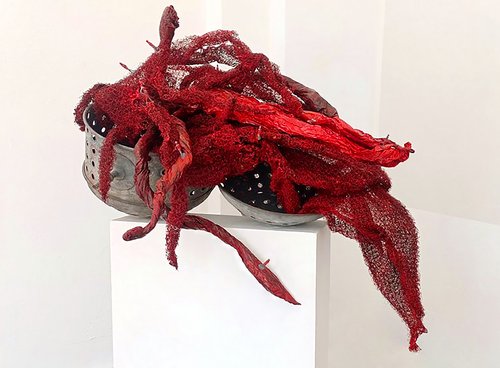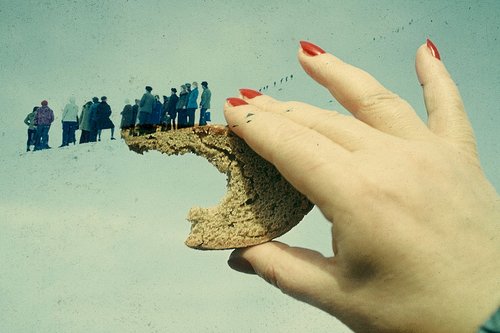Matrix-Ost Exhibition Challenges the Western European Integration Narrative for Eastern European Art

Eleonora Hrybniak. Luftalarm, fortlaufend (Air alarm, continuous), 2024. Photo by Katharina Maria Wimmer. Image from artist's social media page
The Matrix-Ost exhibition at Kesselhaus Museum Herzberge in Berlin presents Eastern European artists who reject Western institutional formats, instead creating a ‘field of objectlessness’ that redefines regional cultural identity through trauma, memory, and self-determination.
“All of contemporary culture, therefore, constitutes a kind of psychiatric institution in no way inferior to an actual house of the mentally ill…” Kazimir Malevich (1879–1935) wrote in his 1922 treatise ‘Suprematism. The World as Non-Objectivity or Eternal Rest’. This paradoxical observation surfaced in my own mind while I was on my way to Matrix-Ost’s unconventional venue.
The route to the ‘Matrix-Ost’ exhibition leads into a part of Berlin where the city has lost confidence in its own urban identity. Eastern Lichtenberg dissolves into fragments: remnants of industrial zones, silent brick buildings from the late nineteenth century echoing imperial ambitions and just beyond them, parks, ponds, and thickly planted trees.
The site itself is a historical palimpsest: founded in 1889 as a psychiatric clinic, this territory survived the Weimar Republic, the Nazi ‘T4’ euthanasia program, the GDR, and the post-socialist transition. And it is here that Malevich’s thesis on culture as a “psychiatric system” ceases to be a metaphor. Any exhibition is constructed upon invisible mechanisms of inclusion and exclusion, where the right to visibility is determined by a complex interplay of institutional interests, sponsors, and political expediency. On a territory where this logic of selection reached its most horrific extremes – a state program for the physical elimination of patients deemed “unworthy of life”, this seemingly specialized question of art history acquires an entirely different ethical dimension. It is in this context that the search for the “field of objectlessness” about which Malevich wrote becomes not merely an aesthetic gesture, but an act of resistance against any utilitarian system that decides who or what has the right to exist.
‘Matrix-Ost’ becomes a space for articulating collective trauma. Crossing the threshold of the exhibition hall, the viewer is immersed in a field of tactile chronicles of anxiety. A work by Ukrainian artist Eleonora Hrybniak is a crocheted blanket where each row corresponds to the days of one year living in Odessa. A blue row marks a day of quiet; a red row, an entire day spent under the wail of air-raid sirens. Nearby, a video by Serbian Nenad Nedeljkov (b. 1971) captures the ephemeral nature of human presence in a silent movement. And the viewer, as if responding to this logic of elusive immateriality, begins to glide through the halls, intuitively feeling for the heart of the exhibition.
In her work ‘Utopia 02’, Moscow-born, Berlin-based Inna Artemova (b. 1972) reflects on the ruins of modernist dreams of the ideal city. Another Muscovite Maria Arendt (b. 1968)’s embroideries become portable memory maps of home, while British Polish artist Ania Ruszkowski’s masks speak of mimicry and self-preservation in a foreign cultural environment. In a piece by Darija Radakovic (b. 1975), a Calgary-based artist born and raised in Bosnia and Herzegovina, an old military blanket becomes a symbolic territory where individual will collides with the collective will as represented by the state. An inscription, warning against surrendering the right to one’s own life and choice to those who act “for your own good,” is a direct challenge to the paternalistic authority that always justifies its actions with “higher aims.”
The exhibition engages with how global conflicts are reflected in the local cultural space, and how artistic statements redefine who tells the history of a region, and from what perspective. The projects of Romania-born, Berlin-based Patricia Morosan (b. 1984) (‘Remember Europe’) and German Oscar Lebeck (b. 1993) (‘Viceversa’) literally rewrite the map. Morosan documents multiple “centers of Europe,” shattering the idea of a single geopolitical focus. Lebeck, through the mirror reflection of border rivers between Germany and Poland, creates an image of the border as a line of communication, not division. In these works, geography becomes a way of speaking about cultural and political relationships, avoiding direct pronouncements but clearly fixing a state of constant revision of zones of influence.
Kazimir Malevich called “practical realism” a disease that demanded of art a utilitarian purpose or service to a political narrative. He saw “objectlessness” as the antidote. ‘Matrix-Ost’ seeks precisely such a field, where art does not build a linear bridge but rather reveals a border zone where document, memory, and abstraction interpenetrate. These works operate on the plane of what decolonial theory calls “aesthesis”, knowledge through sensation, inseparable from the body and from local history. This is an art that refuses to be completely transparent to the external gaze, and it is in this very opacity that a new way of being visible is born.
After the fall of the Berlin Wall and the subsequent collapse of the Soviet Union, the art scenes of Central and Eastern Europe were drawn into a process of accelerated “integration” into Western institutional formats. It was an era that curator Viktor Misiano described as a wave of “Westomania,” when new cultural structures scrambled to adapt to the global art market, often at the cost of losing their own languages. Today, three decades later, against the backdrop of the current geopolitical fractures in Eastern Europe, it is becoming clear that this movement toward the West did not cancel out the need to look at one another: within the region, and to develop forms that cannot be reduced to the role of “catching up.”
This path inward, toward a meticulous, almost archeological investigation of its own cultural strata, is central to the exhibition. But if decolonial aesthesis offers liberation from subordination to an external aesthetic, within Eastern Europe it sets off another trajectory – a critical gaze upon its own myths. In Moscow-born, Berlin-based Anton Laiko’s (b. 1962) ‘Cain + Abel’ and the Russian emigre Pomidor artist duo’s ‘30 Years Later’ irony is turned inward. The artists are in dialogue not with the Western canon, but with figures born of their own cultural field – Malevich and Croatioan artist Mladen Stilinović (1947–2016). Laiko returns Suprematism to its Ukrainian context, transforming abstraction into a metaphor for the acute interstate rupture that became a reality. Pomidor duo, reinterpreting Stilinović’s famous statement, transpose the question of visibility into a sharply local register: how does an artist’s voice sound when their state’s actions place them in a situation of ethical and cultural isolation?
These gestures tear apart the habitual East-West axis and create a field where the East turns toward itself. In this logic, ‘Matrix-Ost’ becomes not a showcase of “regional peculiarities,” but a laboratory where cultural codes are redefined by their own bearers. Here, iconography meets algorithms, as in Russian digital artist Yuri Tolstoguzov’s project ‘AIcons,’ where the canon of the Orthodox icon is compared to the machine vision of neural networks, showing how visual systems can serve as instruments of both sacred and digital control.
We are in the third generational wave of Eastern European art: after the late-Soviet artists of the sixties and the post-socialist artists of the nineties, today’s artists are undertaking a revision of what remains of earlier utopias. ‘Matrix-Ost’ shows that this is not a single history of a region, but a node of intersecting globalizations that in recent years have entered into direct contradiction with one another. The exhibition becomes an act of cultural self-naming. It does not ask to be recognized, it is already naming itself, assembling a language from fragments, from the under-archived, from that which is only now becoming memory but is no longer fact. This is not an attempt at “integration,” but the documentation of a profound and productive misalignment, in which genuine art is born.















